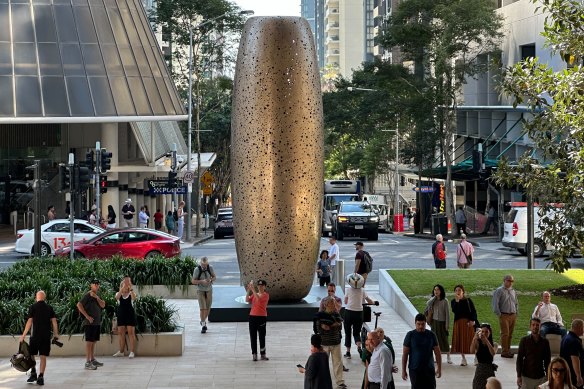- Perspective
- National
- Queensland
- City life
This was published 3 months ago
Which of these is art? It’s a trick question, and I love it if you disagree
I love controversial public art. And if you hate a particular piece, that makes me love it even more.
The new Queen’s Wharf development comes with $13 million worth of art, including Looking Up, Being Swallowed by the Milky Way and the five-tonne bronze Sheila.
Armchair critics are throwing barbs online, arguing the technically brilliant bronze sculptures in Anzac Square are the “true works of art”, while some people complain the new ones look like Slender Man, a space cucumber and a “saggy boob monster”.

Being Swallowed by the Milky Way, an eight-metre high, eight-tonne bronze sculpture by internationally renowned artist Lindy Lee, is one of the public art pieces unveiled as part of the Queen’s Wharf development.Credit: Kristen Camp
But that’s the point. What is art? Is the old stuff better than the new stuff?
The statues in Anzac Square are spectacular for their attention to realistic detail, but I also love Sheila, which Brisbane artist Justene Williams said was inspired by ancient fertility symbols and her young daughter’s fascinations with toy figurines.
“This will be a giant monument to the human form with four breasts, back and front,” she said when the sculpture was revealed.

Sheila by Justene Williams, commissioned as part of Queen’s Wharf, and the Aboriginal and Torres Strait Islander Memorial, in Anzac Square.Credit: Courtney Kruk/Felicity Caldwell
“The name Sheila riffs on the slang term for an Aussie woman, but it is also the female character carved on stone mainly in Europe from the 11th century, which has interpretations of protector, fertility and empathy.”
All the new art was commissioned and paid for by the Queen’s Wharf development, so not taxpayer-funded, and they are in addition to Brisbane City Council’s public art collection of about 200 works, valued about $27 million, in the city and suburbs.
Some of the most significant in the CBD are Forme Del Mito, a set of four bronze sculptures installed at the foot of Jacob’s Ladder on Upper Edward Street; The Guardian, a mythical dog/human carrying a bag with a tree growing out of it on Wharf Street; and Rapture, two vertical human bodies on Market Street.
There’s more, seemingly everywhere you look in the city when you stop to notice it.
Emblem is a giant stainless-steel kangaroo at George and Roma streets by Geoffrey Ricardo, a playful recreation of the kangaroo from the Australian coat of arms.
Amid the current industrial dispute at Cross River Rail, it’s surrounded by CFMEU flags in a makeshift “Solidarity Island” created by union members.
Close by, Freshwater Lens by Judy Watson is a brass sculpture suspended underneath the Turbot Street overpass.
We’ve seen outrage about public art before.
Remember when the $1 million sideways elephant sculpture, The World Turns, was installed outside GOMA in 2012?
Then-arts minister Ros Bates derided it as a “shocking misuse of taxpayer dollars”.
When the Whitlam government bought Jackson Pollock’s Blue Poles for the National Gallery for $1.3 million in 1973, it was the most paid for an American painting in the world at the time, and ridiculed in a Daily Mirror front page: “$1mill. Aust. Masterpiece. Drunks did it.”
Last year it was valued at $500 million.
Asking questions is valid – I’ll no doubt get mixed comments below, and I welcome the debate – but paying for art and supporting artists to do their work (and pay rent and feed their families) builds a more vibrant culture.
Art is evocative, provocative, makes you think, brings beauty to your everyday, and just generally makes life more fun.
I don’t pretend to be an art critic, and I’m not saying you must love all art.
But there’s something about art criticism, especially of the weird, modern and abstract varieties, that makes me love it even more fiercely.